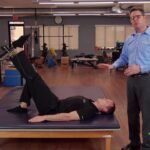Straight Leg Raises
What are Straight Leg Raises?
As a targeted exercise, straight leg raises focus on the muscles in the lower abdominal and thigh areas. To perform this exercise, one must lie on their back with their legs straight, and lift one leg towards the ceiling while maintaining contact between the other leg and the lower back with the floor.
To perform a straight leg raise:
- Lie flat on your back with your arms by your sides and your legs straight.
- Tighten your abdominal muscles and press your lower back into the floor.
- Lift one leg slowly off the floor, keeping it straight and your knee locked. Lift the leg to a height of about 45 degrees.
- After holding the position for a few seconds, it is recommended to slowly lower your leg back to the starting position.
- Repeat the exercise with the other leg.
Early Intervention Benefits of this Exercise
Straight leg raises provide several Early Intervention health benefits, including:
- Strengthening the lower abdominal muscles: By engaging the muscles in the lower abdominal area, such as the rectus abdominis and transverse abdominis, this exercise can significantly improve core strength and stability.
- Strengthening the quadriceps muscles: Performing this exercise can also engage the quadriceps muscles, which are important for knee stability and injury prevention. By strengthening these muscles, the risk of knee injuries can be reduced.
- Improving hip flexor flexibility: This exercise can help to improve flexibility in the hip flexor muscles, which can become tight and shortened with prolonged sitting or inactivity.
- Improving balance and coordination: Performing straight leg raises can improve balance and coordination, as this exercise requires these skills. With regular practice, it is possible to see improvements in both balance and coordination.
- Rehabilitation after injury or surgery: You can do this as a rehabilitation exercise, particularly for regaining strength and flexibility after injury or surgery to the lower body.
Adding straight leg raises to your fitness routine can have numerous benefits. Firstly, it can improve core strength, lower body strength, and flexibility. Additionally, it can enhance balance and coordination. Ultimately, these benefits contribute to an overall improvement in physical fitness.
This Early Intervention exercise promotes strength for the hips and abdomen.
These Early Intervention Exercises are to improve health and fitness.
Before attempting any of these exercises, it is important to consult with a healthcare professional if you have an injury or illness.
More Tools & Resources from Peak Ergonomics
Contact Us About Reducing Workplace Injuries
Healthy Employees are the Bottom Line! – Learn More!

